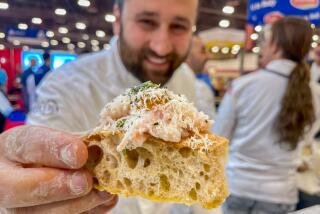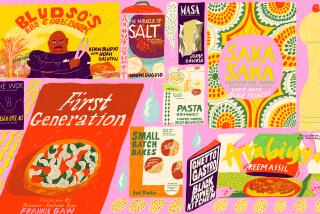Hurry, thereâs still time for a blueberry bonanza
PITY the poor blueberry.
Often it gets lost in the mix, thrown in among brighter, showier berries, or overlooked simply because it seems to be around all the time. Itâs not exactly the most outgoing of berries either, with its broodily dark color and subtle flavor.
But with a trick or two in the kitchen, you can coax this shy berry to shine and even sing. And if you keep an eye out for locally grown ones, youâll hardly have to nudge them and you will wonder why you hadnât been paying attention to them all along.
Once theyâre picked, blueberries are as ripe as theyâll get. So local ones, which have a shorter distance to travel to market, are likelier to be more flavorful than those imported throughout the year from out of state or even out of the country. In Southern California, blueberries thrive in farms along the coast, thanks to a combination of microclimate and cultivation.
Itâs a relatively long local season, starting as early as January and stretching into September, with varying degrees of abundance and flavor depending on the weather. A hot spell can cut short a good cycle. Perfect warm-and-cool conditions can mean a blueberry bonanza. Weâre teetering somewhere in between those two now. So if you havenât been out and about, grabbing them while you can at farmers markets, youâd better hurry.
Pastry chef Dorte Lambert wastes no time. âWe go and taste at every stand and buy whatâs best,â says Lambert, a consultant at Michaelâs restaurant in Santa Monica, where she was one of the original pastry chefs.
For her browned-butter tart, which has been on Michaelâs menu since the restaurantâs early days in the 1980s, she likes blueberries that are crisp and tart.
The berries are scattered within the delicious browned-butter filling that forms a thin top crust as it bakes. âThe butter has to be almost burned -- that creates that nutty flavor,â Lambert says. âIf you donât really bring it to the edge, you just have boring sweet butter.â
Nothingâs boring about this tart, from the crisp crust made with an egg yolk and a touch of cream, to its crowning glory: a heap of glistening blueberries that have been blanched in a simple syrup to bring out their best flavor.
Elizabeth Belkind, pastry chef at Grace, recently served a peach and caramelized apricot jam focaccia on a tasting menu. But the idea goes back to a blueberry-orange version she created for a housewarming brunch last year.
It starts with a dough that, unlike most focaccias, is enriched with butter and thus bakes softer. Then for the topping, Belkind also brings together browned butter and blueberries, but takes that toasted flavor to another level, adding a divine caramelized orange marmalade.
Alan Ashkinaze, chef at Aqua at St. Regis Monarch Beach Resort, recently offered as an amuse a chilled watermelon soup with blueberries. You could also think of it as a fruity aperitif (itâs got a splash of Champagne and touch of orange liqueur), or serve it as a cocktail at a casual brunch (think mimosa) or a palate cleanser for a fancy dinner.
For Ashkinaze, it was a serendipitous soup. âWe had a lot of watermelon and a lot of blueberries,â says the chef, who often buys produce from a roving farmer who delivers to his door. âAnd the blueberries were phenomenal. They were a touch overripe, so they went into a soup.â
You can make the soup base ahead and chill it till youâre ready to serve. When you pour it over, a couple of the blueberries might float to the top, but most will stay below, like little treasures waiting to be discovered.
*
Blueberry browned-butter tart
Total time: 1 hour, 10 minutes plus 1 1/2 hours chilling time
Servings: 6 (4-inch) tarts
Note: From Dorte Lambert, one of the original pastry chefs at Michaelâs in Santa Monica, which still serves her version of this French tart. To make one 9-inch tart, use half of the dough for the crust (you can freeze the other half and thaw it overnight when youâre ready to use it) and all of the filling.
Sweet pastry crust
3 1/4 cups pastry flour
1/2 cup sugar
2 sticks unsalted butter, cold, cut into inch cubes
2 egg yolks
2 tablespoons heavy cream
1. Place the flour and sugar in a large mixing bowl. Add the butter. Using your hands or a pastry cutter, work the butter into the flour until it resembles cornmeal.
2. Whisk the egg yolks and cream together in a small bowl. Drizzle the cream and yolk mixture over the flour mixture.
3. Mix until the dough comes together. Be careful not to over-mix, which makes the dough tough.
4. Remove the dough from the bowl. Divide the dough in half and wrap it in plastic wrap. Flatten into two disks and refrigerate for at least 1 hour. When it is chilled, roll out 1 disk on a lightly floured surface, to a one-fourth-inch-thick round. Using the removable bottom of a 4-inch tart pan as a guide, cut out circles 1 inch larger. Gently fit each circle into the sides and bottom of a tart pan. Remove excess dough by running a rolling pin across the top. Repeat with the remaining dough to line 6 tart pans in total. You will have some extra dough, which may be frozen for another use. Chill the lined tart pans for 30 minutes.
Filling and assembly
1 cup plus 3 tablespoons sugar
3 eggs
1 tablespoon vanilla extract
1/4 cup plus 2 tablespoons
all-purpose flour
1 1/2 sticks unsalted butter, cut into pieces
2 cups blueberries, divided
1/2 cup sugar
1/2 cup water
Powdered sugar
1. Heat the oven to 350 degrees with the baking rack at the lowest position. Place the chilled tart shells on a cookie sheet.
2. In a medium bowl, lightly whisk together the sugar and eggs. Add the vanilla extract, then the flour, whisking together just until combined. Do not over-beat.
3. In a medium saute pan, melt the butter over medium-low heat. Cook the butter to a dark-brown color, about 5 minutes; the darker the color, the nuttier the flavor will be, but be careful not to burn the butter. When the butter is browned, remove it from the heat. Place a whisk in the bowl with the egg mixture and carefully pour in the butter. Having the whisk in the bowl helps prevent the mixture from splattering. Whisk until combined and set aside.
4. Divide 1 cup of blueberries among the 6 tart shells, spreading them evenly; there should be room between the blueberries. Carefully pour the browned-butter mixture over the berries. Bake for 45 to 50 minutes, until the crust is a deep golden brown. (If making a 9-inch tart, bake for 1 hour.) Allow the tarts to cool and remove from the rings. Place each on a serving plate.
5. In a small pan, combine the sugar and water. Bring to a boil. Remove the syrup from the heat and add the remaining blueberries, swirling the mixture quickly. As soon as the blueberries turn dark blue, about 1 minute, immediately pour them into a strainer.
6. Spoon the blanched blueberries on top of the tarts. Sprinkle with powdered sugar. Serve with whipped cream, creme fraiche or ice cream, if desired.
Each 4-inch tart: 960 calories; 10 grams protein; 120 grams carbohydrates; 8 grams fiber; 52 grams fat; 31 grams saturated fat; 284 mg. cholesterol; 45 mg. sodium.
*
Blueberry and caramelized orange marmalade focaccia
Total time: 1 hour, 50 minutes plus 1 hour, 15 minutes rising time
Servings: 20
Note: From pastry chef Elizabeth Belkind of Grace restaurant in Los Angeles. You may substitute a good-quality vanilla extract for the vanilla beans; use 1/2 teaspoon in the marmalade and 1 1/2 teaspoons in the browned butter.
Caramelized orange marmalade
6 medium oranges
3/4 cup granulated sugar
1/4 cup water
1 vanilla bean, split and scraped
3 tablespoons bourbon (optional)
1. With a sharp paring knife, slice the top and bottom off each orange. Then, cut off the peel and pith in swift downward curves, exposing the pulp. Hold the peeled orange over a bowl to catch any juices and cut out the segments by wedging the knife next to the connective membranes on both sides of each segment. You will need 2 cups of fruit with no pith or membrane attached.
2. Strain out half a cup of the orange segments and set aside. Leave the remaining 1 1/2 cups of the segments with the juice.
3. Combine the sugar with the water in a heavy-bottomed nonreactive saucepan, stirring until the mixture resembles wet sand. Add the vanilla bean and seeds. Using a pastry brush or clean fingers, brush down any stray sugar granules on the sides of the pan to prevent the mixture from crystallizing as it caramelizes.
4. Set the pan over high heat and cook the mixture, undisturbed. When it begins to brown, gently swirl and continue cooking until the sugar turns a deep golden brown, 8 to 10 minutes. Add 1 1/2 cups of the orange segments and all of the reserved juice (be careful; the hot caramel will spatter as you do this). Once the spattering subsides, stir the mixture quickly and continuously with a wooden spoon until the marmalade begins to thicken and the bubbles are thick and glossy, about 8 minutes.
5. Add the bourbon, if using, and continue stirring vigorously until the alcohol dissipates, 2 minutes. Add the remainder of the orange segments and stir gently, just until the last of the fruit reaches the same temperature as the marmalade, about 1 minute. Remove from the heat. Discard the vanilla bean. Transfer the marmalade to a flat container with low sides and spread it out as thinly as possible. Cool the mixture and cover the container with plastic wrap and set aside. (Makes 1 1/3 cups marmalade.)
Focaccia
1 1/2 sticks plus 7 tablespoons of butter, divided
1 vanilla bean, split and scraped
2 3/4 teaspoons active dry yeast (will need two packets)
1 3/4 cups warm water (100 to 110 degrees)
1 tablespoon granulated sugar
1 1/4 cups pastry flour
2 1/2 cups plus 7 tablespoons bread flour
2 tablespoons nonfat dry milk
1 teaspoon kosher salt
4 tablespoons raw (turbinado) sugar, divided
1 1/4 cups fresh blueberries
2 teaspoons fresh chopped rosemary
1. Cut the 7 tablespoons of butter into half-inch cubes and set aside, letting them soften. In a small saute pan, combine the 1 1/2 sticks of butter with the vanilla bean and seeds. Over medium-low heat, melt the butter and cook until it begins to bubble and brown. Gently stir, scraping the bottom of the pan. When you see rust-colored specks in the bubbles, the browned butter is done, about 7 minutes. Immediately transfer it to a small bowl and set aside.
2. Place the yeast into the bowl of an electric mixer. Add the water and whisk to dissolve the yeast. Stir in the granulated sugar. Add the pastry flour, bread flour, nonfat dry milk and salt. Using the dough-hook attachment, mix on low about 2 minutes, scraping the sides and bottom of the bowl if needed. Turn the speed up to medium and knead the dough for 6 minutes. Add the cubed, softened butter and continue kneading until the butter is completely incorporated. (The dough will be soft.)
3. Brush a clean, large bowl with a generous amount of the browned butter. Scrape the dough out of the mixing bowl and into the buttered bowl. Gently brush the top of the dough with more of the brown butter. Cover the bowl tightly with plastic wrap. Set it in a warm place and allow the dough to rise until it doubles, about 45 minutes.
4. Heat the oven to 400 degrees. Line two baking sheets with parchment paper; grease with browned butter. Brush a cutting board with a small amount of browned butter. Turn the dough out onto the board. Using a pastry scraper, halve the dough and scoop each half onto a baking sheet. Using the palms of your hands and your fingertips, flatten the dough, starting at the center, and coax it into a 10-inch circle with edges slightly higher than the center. Gently brush the dough with browned butter again. Lightly cover the dough with a clean, damp kitchen towel and set in a warm place for 30 minutes. When the dough has risen, gently press your fingertips to form dimples all over the surface. Brush with the rest of the brown butter.
5. Sprinkle half of the raw sugar over each of the focaccia rounds. Gently and generously brush about half of the caramelized orange marmalade over each round (you may have a tablespoon or two left over), then sprinkle with half of the blueberries and half of the rosemary. Bake 15 to 20 minutes, rotating the baking sheets 180 degrees halfway through to allow for even browning. When done, the top of the focaccia will be soft to the touch.
6. Cool for about 10 minutes. Cut each focaccia into 10 wedges. Serve warm.
Each serving: 260 calories; 4 grams protein; 37 grams carbohydrates; 3 grams fiber; 11 grams fat; 7 grams saturated fat; 29 mg. cholesterol; 60 mg. sodium.
*
Watermelon blueberry soup
Total time: 30 minutes plus
1 hour steeping time and
chilling time
Servings: 8
Notes: From chef Alan Ashkinaze of Aqua at the St. Regis Monarch Beach Resort. He serves this as an amuse, but it also makes a terrific cocktail or even dessert.
1/4 cup sugar
1 cup water
2 tablespoons white wine
1 stalk lemongrass
1 1/2 cups cubed red seedless watermelon
3/4 cup cubed ripe peach (about 1)
1/2 cup cubed cantaloupe
1/4 cup blueberries, divided
1/4 cup fresh-squeezed orange juice
1 1/2 teaspoons mint
chiffonade
Pinch of cayenne pepper
1 1/2 teaspoons Cointreau,
divided
6 tablespoons Champagne or sparkling white wine
3 tablespoons club soda
1. Combine the sugar, water, white wine and lemongrass in a saucepan. Bring to a boil. Lower the heat and gently simmer, uncovered, for 20 minutes. Turn off the heat and let the mixture steep for at least 1 hour. Strain and set aside.
2. In a blender, combine the watermelon, peach, cantaloupe and half of the blueberries. Puree until smooth. Strain the mixture through a chinois or fine sieve (if you have a juicer, you can use it instead of a blender and skip this step because a juicer will strain the fruit.) Add the orange juice and some of the lemongrass simple syrup to taste, about 1 to 2 tablespoons. Chill the mixture.
3. Just before serving, cut the remaining blueberries in half and place in a small bowl. Add the mint, ground cayenne pepper, a pinch of salt and 1/4 teaspoon of Cointreau. Stir gently and divide among 8 demitasse cups.
4. To the watermelon mixture, stir in 1 1/4 teaspoons Cointreau, the Champagne and club soda. Divide the mixture among the cups, pouring over the blueberries. Serve immediately.
Each serving: 62 calories; 0 protein; 13 grams carbohydrates; 1 gram fiber; 0 fat; 0 saturated fat; 0 cholesterol; 2 mg. sodium.
More to Read
Eat your way across L.A.
Get our weekly Tasting Notes newsletter for reviews, news and more.
You may occasionally receive promotional content from the Los Angeles Times.









